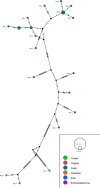Phylodynamics of classical swine fever virus in Brazil
- PMID: 35394611
- PMCID: PMC9151941
- DOI: 10.1007/s42770-022-00724-2
Phylodynamics of classical swine fever virus in Brazil
Abstract
The classical swine fever virus is the etiologic agent of one of the diseases with the greatest impact on swine farming worldwide. An extensive area of Brazil is considered free of the disease, but some states in Northeast Brazil have registered outbreaks since 2001. The objective of this study was to analyze the genetic variations of the virus and its spread over time and space. Partial sequences of the viral E2 protein obtained from samples collected during the Brazilian outbreaks were compared with sequences from the GenBank database (NCBI). The results demonstrated the continuous presence of the virus in the state of Ceará, with diffusion to at least two other states. The Brazilian Northeast virus presents specific polymorphisms that separate it from viruses isolated in other countries.
Keywords: Classical swine fever; Evolution; Hog cholera; Phylogeny.
© 2022. The Author(s) under exclusive licence to Sociedade Brasileira de Microbiologia.
Conflict of interest statement
The authors declare no competing interests.
Figures






Similar articles
-
Application of genetic methods to study the relationship between classical swine fever outbreaks.Res Vet Sci. 1998 Jul-Aug;65(1):89-90. doi: 10.1016/s0034-5288(98)90035-2. Res Vet Sci. 1998. PMID: 9769081
-
Emergence of 2.1. subgenotype of classical swine fever virus in pig population of India in 2011.Vet Q. 2014;34(4):224-8. doi: 10.1080/01652176.2014.973122. Epub 2014 Nov 3. Vet Q. 2014. PMID: 25365116
-
Identification and genetic characterization of classical swine fever virus isolates in Brazil: a new subgenotype.Arch Virol. 2017 Mar;162(3):817-822. doi: 10.1007/s00705-016-3145-8. Epub 2016 Nov 5. Arch Virol. 2017. PMID: 27815697
-
Achievements and Challenges of Classical Swine Fever Eradication in Brazil.Viruses. 2020 Nov 19;12(11):1327. doi: 10.3390/v12111327. Viruses. 2020. PMID: 33227889 Free PMC article. Review.
-
Classical Swine Fever-An Updated Review.Viruses. 2017 Apr 21;9(4):86. doi: 10.3390/v9040086. Viruses. 2017. PMID: 28430168 Free PMC article. Review.
Cited by
-
Global population dynamics and evolutionary selection in classical swine fever virus complete genomes: insights from Bayesian coalescent analysis.Virus Genes. 2025 Aug;61(4):464-473. doi: 10.1007/s11262-025-02154-2. Epub 2025 Apr 8. Virus Genes. 2025. PMID: 40198523
-
Molecular and Pathological Characterization of Classical Swine Fever Virus Genotype 2 Strains Responsible for the 2013-2018 Outbreak in Colombia.Viruses. 2023 Nov 24;15(12):2308. doi: 10.3390/v15122308. Viruses. 2023. PMID: 38140549 Free PMC article.
References
-
- Freitas TRP, Esteves, EG , Oliveira, AM et al. (2007) Classical swine fever in Brazil: study for the survey of classical swine fever outbreaks in Brazil from 1978 to 2004. Semina: Ciências Agrárias 28(2):277–286.
-
- Freitas TRP, Souza AC, Esteves EG, Lyra TMP. Classical swine fever in Brazil: an update. Journal of Agricultural Science and Technology A. 2012;2:997–1002.
MeSH terms
Substances
LinkOut - more resources
Full Text Sources

